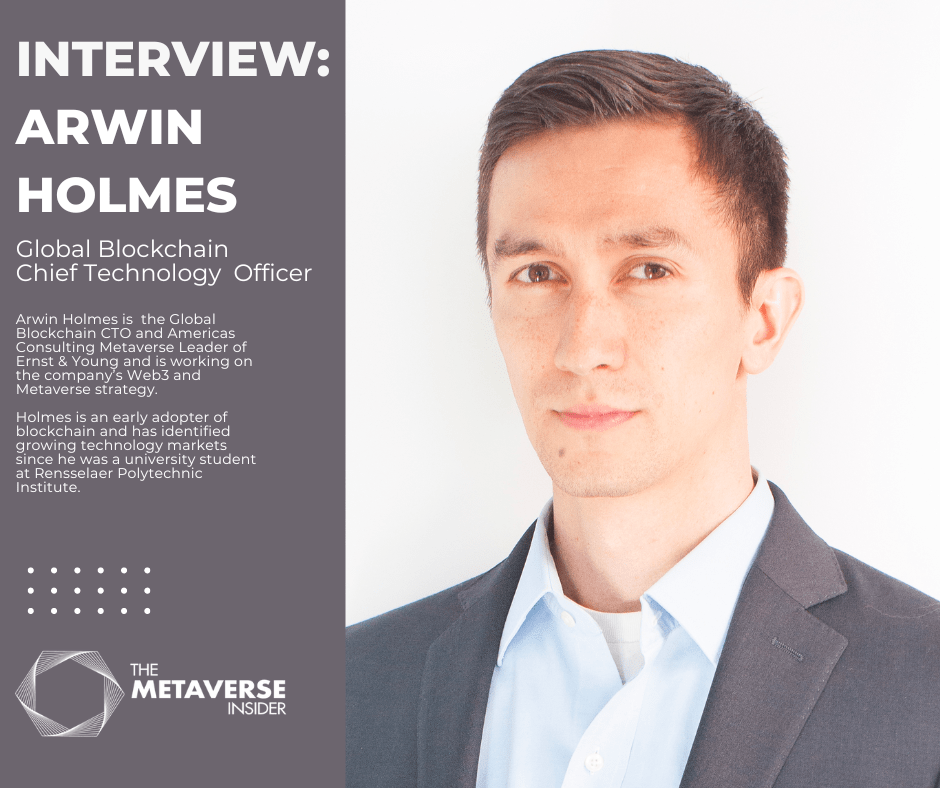Metaverse Insider has closely been following EY’s projects and investments in blockchain and the metaverse ecosystem. We’ve previously interviewed Paul Brody, Global Blockchain Leader and Jeff Wong, Global Chief Innovation at Ernst & Young. We’ve gotten great insights from both market leaders who were early adopters of this industry. Recently, EY launched EY Wavespace and EY Metaverse Lab to help clients transform for the decentralized economy driven by the metaverse and web3.
Recently, we were at the Economist’s Metaverse Summit in San Jose, where we came across Arwin Holmes. Holmes is an early adopter of blockchain and has identified growing technology markets since he was a university student at Rensselaer Polytechnic Institute. He is the Global Blockchain CTO and Americas Consulting Metaverse Leader of Ernst & Young and is working on the company’s Web3 and Metaverse strategy as well.
I started my conversation with Arwin by asking about his background and how he got to EY.
“My entire career, I’ve been focused on emerging technologies and open source, which, as you know, lends itself quite well to blockchain technology. I made a personal decision back in 2016 to focus on this tech. We had a lot of members of my open-source engineering team as part of my previous firm that was dabbling in this space. I started to see some of that change, especially with the coming of Ethereum as a smart contract platform. And that’s when I worked on building some of the firm’s first prototypes around this technology. And shortly after that, EY formalized a global blockchain practice with Paul Brody, whom I know you’ve already spoken with as our global leader. And it’s been an amazing journey working with Paul since 2016. We’ve been very bullish on public blockchains from the get-go. And it’s been exciting to see the market also come around to that and pointing to terms like web3, which is still very much in the spirit of open source. So, for me that that bodes very well in terms of what I see as a promise for the future!”
Arwin was a Partner and led the open-source practice for a technology consulting firm that was acquired by EY in 2015. Since then, he has worked in emerging technologies with Ernst & Young and was a founding member of EY’s blockchain team. My next question was asking him how much the blockchain industry has changed since 2016 up until now in 2022.
“We’re here at the Economist Impact Conference, right? We’re just heavily focused around the metaverse. I see this [conference as] reminiscent of the 2016 days where, when it comes to Metaverse, many, many of the folks here are asking the question, what’s a good use case? But that was the primary question when we discussed blockchain back in 2016. Even in our first few years of business, we did hundreds of proof-of-concepts with clients. So, a lot of experimentation looking for good use cases.”
“Fast forward to now, I will say that when it comes to web3 and blockchain, my personal belief is that this is already transitioning from early adoption to mainstream adoption in specific industries and use cases. And much of that comes with signals, particularly around the regulatory landscape – starting with the OCC letter on January 4, last year, that helped clarify crypto policy for banks. To me, that was a huge tipping point in the market. And something that hasn’t slowed in terms of adoption, right and interest, and likely won’t be going away. So, I know there are still skeptics that we heard today that say the ship has already sailed when it comes to decentralized web and crypto. But I think that we’re still in the early days [of mainstream adoption].”
“The next wave of adoption will be around the basic use cases. Bitcoin first came out as a new medium of exchange and value and the most basic medium of exchange of value is around payments. So, I think that is more broadly still to be realized. But we’re still starting to see signals of this in the market, at the enterprise level, as well as at the consumer level.”
“For example, we see big companies like Google and others that are partnering with crypto natives like Coinbase to support accepting payment [in crypto]. Using this means for crypto [payments] to eCommerce platforms that are also doing similar with other crypto natives this is supporting broader connectivity and adoption. I think very soon this is going to be impacting employers and employees.”
“Another pay-by-crypto use case is payroll to get employees their paychecks in crypto, and the next logical thing is merchants will also need to be able to accept [crypto]. So, this is just a natural evolution. But this [evolution will] first and foremost start with basic crypto representing digital fiat and cash as we know it today.”
“But this will continue to evolve [beyond tokenized fiat to include a broader set of digital assets]. Think about the early days of a barter system before we had currency. I can have another token of value (digital asset) that I might trade for something else of equivalent value. But we’re not there yet. That’s gonna involve a lot more innovation around tokenization, which we see starting to mature as well.”
Arwin gave a very detailed breakdown of the metaverse and blockchain ecosystem. He talked about certain immediate use cases and how they will evolve over time. Next, I asked him why EY has been focusing on public blockchains.
“Our view on [public blockchains] has evolved over time. So, I would also just caveat that we started out with Ethereum. But it’s more accurate to say we’re open to public blockchains and more specifically EVM-compatible chains. For Ethereum-compatible chains, like Polygon, for example, we’ve been very public about our collaboration with them. With Polygon Nightfall, for example, we’re building for both privacy and scalability, which are two things that we see enterprises needing to adopt public blockchains. So, we’re really trying to address those challenges head-on, to enable enterprise adoption and by partnering with public protocols. This collaboration with the community has been huge!”
“The value of this and understanding the underlying tech is really important here. We didn’t see the value in private blockchains because you don’t get the network effects you would get using this technology (public blockchains). If you are going to create a walled garden (private blockchain) using blockchain, you’re essentially using a technology that is the equivalent of a really bad database right now without getting the benefits of the broader network. And you’ll likely get more gains by taking a more traditional route using traditional database systems to get you much faster transaction throughput for private use cases. But maybe not the same degree of resiliency. At the end of the day, if you’re running a private blockchain, you’re still dealing with a central operator of that network or a collection of central operators in the network! And there’s still the trust model that isn’t the same either, you’re still relying heavily on a central party to make sure that the network is up and running and properly managed, and whatever data is going onto that ledger is something that you’re also, by extension, trusting that central party to maintain.”
“What’s cool about web3 and public blockchains is that we get the additional network effects and the resiliency of at least something truly decentralized. And some other public blockchains out there are challenged with those [network effects and resiliency] because they don’t have the same degree of adoption. The networks are not the size of Ethereum. Because of that, we’ve seen, especially over this past year, some popular public protocols have experienced significant downtime. And that’s because they’re not sufficiently decentralized. So, I think it’s really important that as folks consider what chain they build on top of, they look at the degree of decentralization and how well adopted the network is because those are the networks that will be the most resilient.”
“That is also for new incumbents entering into the space, gaining adoption can be the hardest thing to catch up to and overcome. So, I think anybody else that wants to launch their own public blockchain, it’s going to be very hard to get to the scale that Ethereum has gotten to and other EVM compatible chains. I think Polygon did a good thing by building on top of Ethereum as a layer 2, because they’re accretive to the ecosystem and they’re solving a different problem as a transactional layer with lower gas fees.”
Arwin’s point of view about public and private blockchains is very clear. The EY leadership has consistently been pro-Ethereum. Naturally, I asked Arwin about the Ethereum merge and how it effects layer 2 blockchains after this merge.
“We’re post-merge now – a testament to the amazing engineering capabilities of a decentralized open-source community, and a culmination of years of effort! But I do think there are going to be bespoke use cases where certain networks have [native cross-chain] interoperability built-in, which I think is still really important. Because certain workloads are gonna have different requirements. Like if you want to support a gaming use case, maybe supporting a supply chain right now, maybe you don’t care so much about privacy? Or maybe you do. Maybe you care more about security. Or maybe you don’t! If it’s something that will be in the public domain anyway, do you care about the privacy controls or features for [your use case]? If not, then use a chain that doesn’t have privacy features. I think those considerations are not just for bespoke use cases either, but what are the additional use cases that are going to interoperate and build on top of [your solution/ecosystem].”
“Some of the early adopters and some of our clients are still here, where they’re looking at a single use case for why they’re leveraging blockchain technology. But the value of the stack is as a foundational technology component upon which you can support multiple use cases. And ideally, that’s something that’s compounding. So maybe today, if I’m using this for supply chain, I’m using it as a certificate of authenticity to prove that whatever you’re holding (is authentic).”
“We (EY) did this first for Italian wine, right? And you can tokenize it and put the QR code on a bottle, and then I can prove to you that this [bottle] is indeed an Italian wine and not counterfeit. [Wine] is one of the most counterfeited products in Italy! Then beyond [certificate of authenticity], you can also show provenance, right? We layer on ESG! You can show that this is carbon neutral. And some of these things are nice to have today, but tomorrow, pending regulation, may be must-have!”
“These are some examples of building blocks for you to build upon in other use cases. And then eventually, you get to a place where… Okay! Now I have an optimized supply chain that I built on top of web3. I’ve done that! I have very clear visibility around my inventory, to the point where it’s 100% accurate. Now I can reduce my safety stock to zero and get efficiencies across my entire value chain. But then beyond that, I can do automation, like automated replenishment, for example, and other things around contracting and procurement, like so many, many different layers that can be built on top of [these building blocks]. And there’s still a lot to do on foundational capabilities off-chain. Like the first one that we see a lot of clients unpacking is just the concept of custody, how am I going to hold these assets and secure them? That’s a very basic but critical thing.”
Arwin has been working in the blockchain space since the early days of this technology. His in-depth knowledge of the possible use cases is interesting to listen to. At the conference where I met Arwin, EY was introducing many of its metaverse investments and offerings. So I asked Arwin about EY’s metaverse investments and how it helps EY clients.
“On the metaverse front, we’re exploring quite a bit. The big theme for us here at the Economist Impact Conference is keeping humans at the center. And focusing on the impact that we have in society and then how we can best leverage this technology. I think there have been some missteps in the past. Someone at a prior roundtable shared that suicide rates for young women have tripled since social media came about. To me, that’s a new stat that I wasn’t even aware of. It’s something we need to be considering, right? What are some of the controls and considerations we need to put in place to manage against these risks? Because that is a very real one for me personally! I have a daughter and a son. I don’t want them to think they need to get validation through one of these channels, but that’s the society we’re in right now.”
It was refreshing to know that Arwin is considering the downsides of the metaverse along with the upsides. He explains how EY is working on the challenges the firm is tackling in the metaverse.
“A lot of what we do is why our brand goes hand in hand with trust and risk management. On the web3 front, digital assets are where I spend most of my time currently. I’m helping our clients understand what those net new and incremental risks are. So, they’re coming in with both eyes open now, which takes many dimensions. There’s operational, there’s technical, and there’s the regulatory aspects. Every institution has its own enterprise risk framework that’s going to require some incremental updates and some new changes to support embracing any new technology!”
“It’s not specific to web3, or Metaverse, it can be any tech. But those are areas where we’re heavily focused. So, we have offerings around token due diligence, for example. If you offer a token as a product to your customers, how do you know that you can right? Or should? Are you just going to pass that responsibility on to the buyer? That’s maybe not socially or ethically responsible to do. It’s probably good that you go through this [token due diligence and onboarding] process, and some of them have regulatory compliance obligations to do so.”
“As we get into Metaverse, there’s a lot of uncharted territory. But I think a lot of the stuff that came out of the conference today is a lot of stuff that already exists in the physical world. If you already had a code of conduct as a corporation, that’s something that helps govern how people act in a corporate setting in the physical or the real world. And that will translate to how this will translate to the virtual world, too. If you’re going to bring those capabilities, you know, those [metaverse] experiences into your environment, you probably need to consider how you evolve your code of conduct to be inclusive of this new experience layer. So, there are some good models, again, I think 90% of it is probably incremental updates to what corporations already have. And we’re helping advise them on that.”
“When it comes to these newer technologies, we start with strategy, commercial and product strategy, giving [our clients] market insights. We then go into implementation design, focusing on what are the steps they should be mobilizing around now, in the next two to five years, and then beyond? And because not everything needs to be done here and now, right? It depends on where you are, and what value chain you’re in, and where you want to be and what your competitive edge is in the market. It’s different for every client.”
“In emerging tech, we’re in every industry, and we have professionals in every domain that you can think of when it comes to the risks. There are very few organizations that can come to you with the regulatory compliance view, the tax view, the audit view, the technology view, right? And the operational view and the strategic industry view. To be able to give you a holistic picture of what this [technology] means for you and be pragmatic about the value that you can get from it. Those are the sorts of cross-functional insights we bring to our clients, and we help them think through their strategic direction and then we partner and work together to realize the real value!”
Metaverse Insider would like to thank Arwin Holmes for his time during a very busy Metaverse conference. We will continue to cover EY’s projects and developments in the blockchain and metaverse space!
For more interesting and world news, be sure to check out metaverse news today!

















